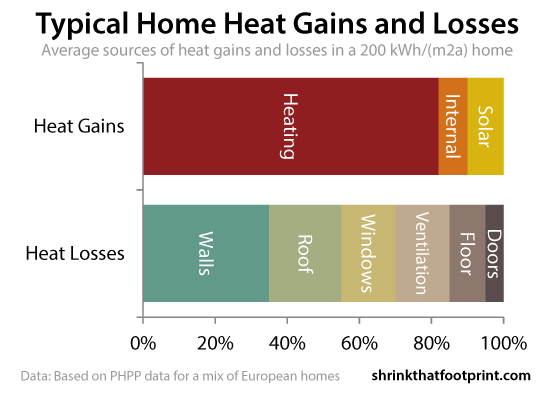Typical Home Heat Gains & Losses
Originally published on Shrink That Footprint
by Lindsay Wilson
This is the fourth post in our Beginner’s Guide to Heating Bills, it follows average heating bills, heating fuel use and heating cost comparisons.
In the first post of this series I mentioned that the thing that you are really paying for in your heating bill is heat loss.
All a heating system does is top up heat that is lost over the course of a year.
Where heat is gained and lost
Because a house remains roughly the same temperature over the course of a year its heat gains are equal to its heat losses. We can thank the first law of thermodynamics for this.
Heat gains come from heating systems, the sun’s warmth and internal gains from things like appliances and body heat. Heat losses occur through convection in the walls, floor, roof, windows and doors or via ventilation in the form of air leakage.
In the image above I’ve shown the typical shares of heat gains and heat losses for an average European home. The major sources of losses are walls (35%), roof (20%), windows (15%), ventilation (15%), floor (10%) and doors (5%).
When you see figures like this it is important to remember they are only generalizations. If you live in an mid story apartment with neighbors above, below and to your sides, your floor and roof heat loss will be non-existent. Windows, external walls and ventilation will instead dominate heat loss.
Reducing heat loss reduces heating needs, and hence bills. This can be done by improving the insulation of your building’s envelope, improving air tightness or turning down the thermostat.
The effect of thermostat temperature settings is what we look at next.
Have a tip for CleanTechnica? Want to advertise? Want to suggest a guest for our CleanTech Talk podcast? Contact us here.
Latest CleanTechnica.TV Video

CleanTechnica uses affiliate links. See our policy here.


